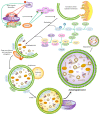Autophagy in Hematological Malignancies
- PMID: 36291856
- PMCID: PMC9600546
- DOI: 10.3390/cancers14205072
Autophagy in Hematological Malignancies
Abstract
Autophagy is a highly conserved metabolic pathway via which unwanted intracellular materials, such as unfolded proteins or damaged organelles, are digested. It is activated in response to conditions of oxidative stress or starvation, and is essential for the maintenance of cellular homeostasis and other vital functions, such as differentiation, cell death, and the cell cycle. Therefore, autophagy plays an important role in the initiation and progression of tumors, including hematological malignancies, where damaged autophagy during hematopoiesis can cause malignant transformation and increase cell proliferation. Over the last decade, the importance of autophagy in response to standard pharmacological treatment of hematological tumors has been observed, revealing completely opposite roles depending on the tumor type and stage. Thus, autophagy can promote tumor survival by attenuating the cellular damage caused by drugs and/or stabilizing oncogenic proteins, but can also have an antitumoral effect due to autophagic cell death. Therefore, autophagy-based strategies must depend on the context to create specific and safe combination therapies that could contribute to improved clinical outcomes. In this review, we describe the process of autophagy and its role on hematopoiesis, and we highlight recent research investigating its role as a potential therapeutic target in hematological malignancies. The findings suggest that genetic variants within autophagy-related genes modulate the risk of developing hemopathies, as well as patient survival.
Keywords: autophagy; autophagy-related variants; clinical outcomes; disease progression; hematological malignancies; hematopoiesis; patient survival; therapeutic target.
Conflict of interest statement
The authors declare no conflict of interest. The funders had no role in the writing of the manuscript, or in the decision to publish the reviewed material.
Figures

Similar articles
-
Crosstalk Between Autophagy and Oxidative Stress in Hematological Malignancies: Mechanisms, Implications, and Therapeutic Potential.Antioxidants (Basel). 2025 Feb 25;14(3):264. doi: 10.3390/antiox14030264. Antioxidants (Basel). 2025. PMID: 40227235 Free PMC article. Review.
-
Autophagy as a target for hematological malignancy therapy.Blood Rev. 2016 Sep;30(5):369-80. doi: 10.1016/j.blre.2016.04.005. Epub 2016 Apr 16. Blood Rev. 2016. PMID: 27132115 Review.
-
Autophagy in Hematological Malignancies: Molecular Aspects in Leukemia and Lymphoma.Lab Med. 2021 Jan 4;52(1):16-23. doi: 10.1093/labmed/lmaa027. Lab Med. 2021. PMID: 32634208 Review.
-
Regulation of autophagy by sphingolipids.Anticancer Agents Med Chem. 2011 Nov;11(9):844-53. doi: 10.2174/187152011797655131. Anticancer Agents Med Chem. 2011. PMID: 21707487 Review.
-
Autophagy in acute leukemias: a double-edged sword with important therapeutic implications.Biochim Biophys Acta. 2015 Jan;1853(1):14-26. doi: 10.1016/j.bbamcr.2014.09.023. Epub 2014 Oct 2. Biochim Biophys Acta. 2015. PMID: 25284725 Review.
Cited by
-
Identifying functional roles and pathways of shared mutations in canine solid tumors by whole-genome sequencing.PLoS One. 2025 May 30;20(5):e0307792. doi: 10.1371/journal.pone.0307792. eCollection 2025. PLoS One. 2025. PMID: 40446009 Free PMC article.
-
Autoimmunity and Carcinogenesis: Their Relationship under the Umbrella of Autophagy.Biomedicines. 2023 Apr 8;11(4):1130. doi: 10.3390/biomedicines11041130. Biomedicines. 2023. PMID: 37189748 Free PMC article. Review.
-
Crosstalk Between Autophagy and Oxidative Stress in Hematological Malignancies: Mechanisms, Implications, and Therapeutic Potential.Antioxidants (Basel). 2025 Feb 25;14(3):264. doi: 10.3390/antiox14030264. Antioxidants (Basel). 2025. PMID: 40227235 Free PMC article. Review.
-
Hypoxia-initiated Cysteine-rich protein 61 secretion promotes chemoresistance of acute B lymphoblastic leukemia cells.Am J Cancer Res. 2024 Jul 15;14(7):3388-3403. doi: 10.62347/CKMT4065. eCollection 2024. Am J Cancer Res. 2024. PMID: 39113880 Free PMC article.
-
Chemotherapy's effects on autophagy in the treatment of Hodgkin's lymphoma: a scoping review.Discov Oncol. 2024 Jul 8;15(1):269. doi: 10.1007/s12672-024-01142-6. Discov Oncol. 2024. PMID: 38976168 Free PMC article.
References
-
- Costas M.A., Rubio M.F. Autophagy. A strategy for cell survival. Medicina. 2017;77:314–320. - PubMed

